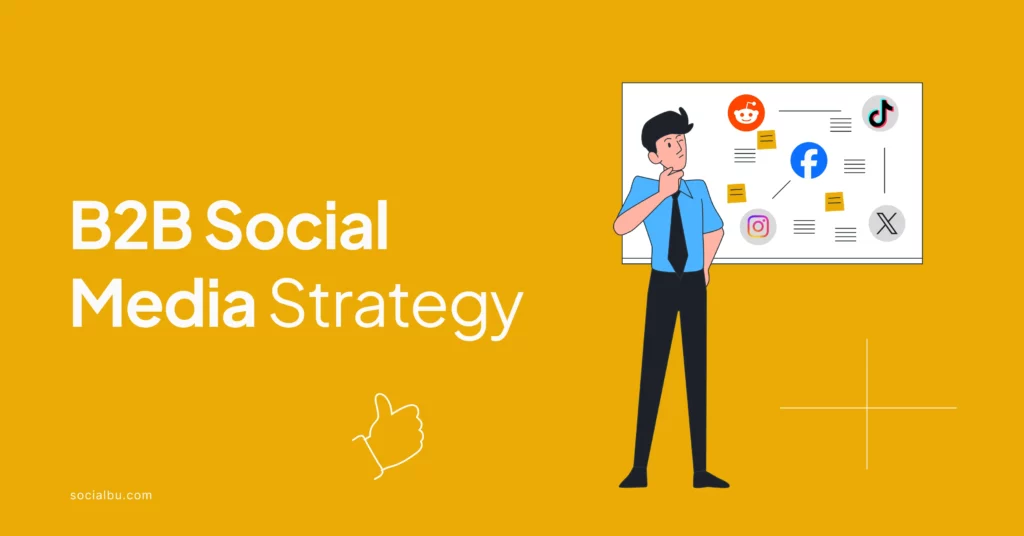According to B2B social media marketing statistics, the average person spends nearly two and a half hours on social media daily. Moreover, a B2B social media strategy is crucial since 90% of social media users follow at least one brand. Nonetheless, simply being on social media isn’t enough. You need a well-crafted B2B social media strategy that aligns with your business goals to succeed.
Let’s explore how to do this!
What is a B2B Social Media Strategy?
A solid social media presence is no longer optional for B2B businesses. With over 5.07 billion social media users worldwide, it’s a powerful way to connect with your target audience, build brand awareness, and drive leads.
A B2B social media strategy is a comprehensive plan that outlines how a business will use social media platforms to connect with other businesses and achieve marketing goals.
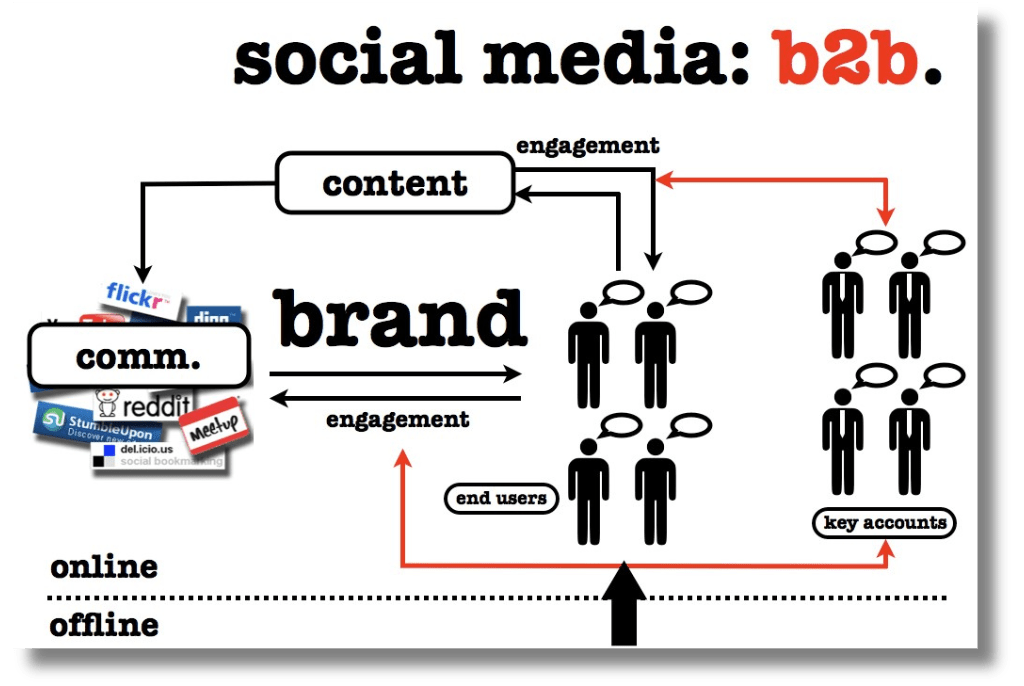
Unlike B2C (business-to-consumer) marketing, which focuses on individual consumers, B2B marketing involves building relationships with other businesses to generate leads and sales.
Nevertheless, B2B social media marketing is essential for businesses looking to stay ahead of their competitors in the digital landscape.
Elements to Include in B2B Social Media Strategy
Whether you are a small business owner, a B2B social media agency owner, or a founder of a large corporation, crafting a winning B2B social media strategy is your key to success.
Focusing on a few key elements that contribute to an effective strategy can help you develop a B2B social media strategy that drives results.
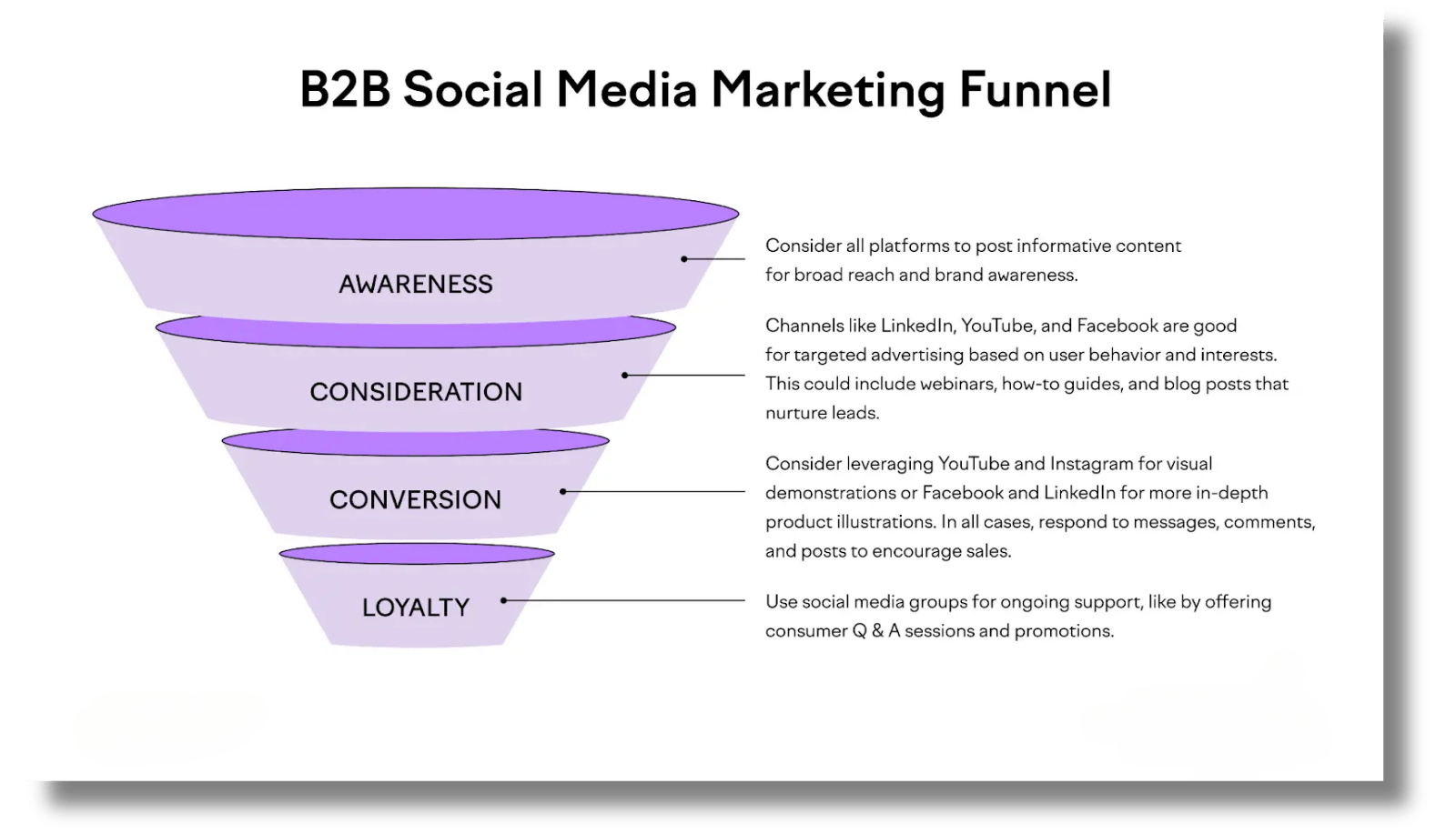
Let’s take a look at these elements below:
Clear Objectives
A well-defined social media strategy starts with setting clear objectives. To maximize the effectiveness of your B2B social media strategy, it is crucial to align your social media objectives with your broader business goals. This will create a roadmap for your B2B social media efforts that drive meaningful results.
For example, suppose your business goal is to increase sales by 20% over the next year. In that case, your social media objective might focus on generating a specific number of leads through targeted campaigns.
This alignment with your KPIs ensures that your social media efforts and content strategy contribute directly to your business’s success and provide a clear framework for measuring progress.
Types of Objectives
B2B companies can pursue various objectives through their social media strategies. Common objectives include:
Increasing Brand Awareness
This involves enhancing your company’s visibility and recognition within your target market. By sharing valuable content and engaging with your audience, you can establish your brand as a trusted authority in your industry.
Generating Leads
Social media can be a powerful tool for lead generation. Creating targeted campaigns and sharing compelling content can attract potential customers and encourage them to provide their contact information.
Improving Customer Engagement
Engaging with your audience fosters relationships and builds loyalty. This objective focuses on increasing interactions with your followers through comments, shares, and direct messages, ultimately leading to a more connected community.
Driving Website Traffic
Another objective is to use social media to drive traffic to your website. By sharing links to valuable resources, blog posts, or product pages, you can encourage your audience to visit your site and explore your offerings.
Best B2B Social Media Examples
Here are some B2B social media examples below, and create yours accordingly:
- Increase brand awareness by [percentage] within [timeframe].
- Generate [number] leads through social media channels within [timeframe].
- Drive [percentage] increase in website traffic from social media referrals.
- Build a community of [number] followers on [platform].
Remember, setting clear and measurable goals allows you to track your progress, make data-driven decisions, and use social media to contribute to your business’s success.
Understanding of Target Audience
Developing detailed buyer personas is a crucial step in understanding your target audience for your B2B social media strategy. These personas include demographic information, such as job titles, company sizes, locations, and psychographic data, including pain points, goals, and decision-making processes.
Research your audience’s pain points by analyzing industry trends, reading relevant publications, and engaging with them on social media. Look for common issues, frustrations, and challenges in their roles or industries. Based on these findings, set your content pillars.
Once you clearly understand your target audience, customize your content to their preferences and behaviors. Pay attention to the topics, formats, and tones that resonate with them. This is essential for creating content that resonates with them and building credibility.
For example, if your audience prefers concise, actionable content, create short, informative blog posts or video tutorials. If they are interested in industry trends and insights, consider developing in-depth whitepapers or webinars.
Choosing the Right Social Media Platforms
Rather than spreading your resources too thin across multiple social media channels, it is advisable to focus your efforts on a few key platforms. Prioritizing a select number of platforms allows you to allocate your time and resources effectively.
Besides, setting your content calendar becomes easier this way, too.
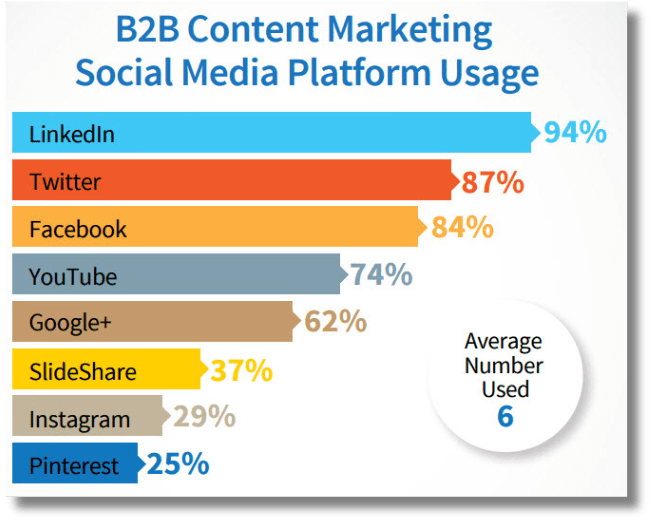
Evaluating Platform Suitability
Start by evaluating each platform’s suitability based on your target audience and the type of content you plan to share. Consider the platform’s primary use, user demographics, and engagement levels.
For instance, LinkedIn is ideal for professional networking and sharing industry insights, while Twitter is effective for real-time updates and engaging in conversations.
Analyze where your audience spends their time and which platforms align best with your business objectives.
Understanding Platform Demographics
Each social media platform attracts different user groups based on age, profession, and interests. Thus, you must only concentrate on the platforms that yield the best results for your goals.
This way, you can ensure that your content reaches the right audience and aligns with their preferences, ultimately enhancing engagement and lead generation.
Creating a Content Strategy
When creating a B2B social media strategy example, consider incorporating various content formats that have proven effective in the B2B space. These include the following:
- Whitepapers: In-depth, research-driven reports that provide valuable insights and analysis on industry topics.
- Case Studies: Real-world examples showcasing how your products or services have helped clients achieve their goals.
- Infographics: Visual representations of data or information that are easy to digest and share.
- Videos: Engaging content that can be used for product demos, interviews with industry experts, or educational tutorials.
- Blog Posts: Informative articles that address common pain points and showcase your brand’s expertise.
Diversifying your content mix when curating content will likely make you appealing to different learning preferences and keep your audience engaged. Besides, a B2B social media strategy template can come in handy here.
Focus on providing value to your audience. Your content should address their specific needs, challenges, and goals. Avoid overtly promotional content and position your brand as a trusted resource and thought leader.
Experienced B2B or SaaS marketing agencies excel at this balance, crafting content that demonstrates industry expertise while subtly nurturing potential clients through their decision-making journey.
Implementing a Content Calendar
A content calendar helps you visualize your content strategy, making it easier to identify gaps, overlaps, or opportunities for improvement.
Additionally, it allows for better collaboration among team members, as everyone can see what B2B social media content ideas are planned and when.
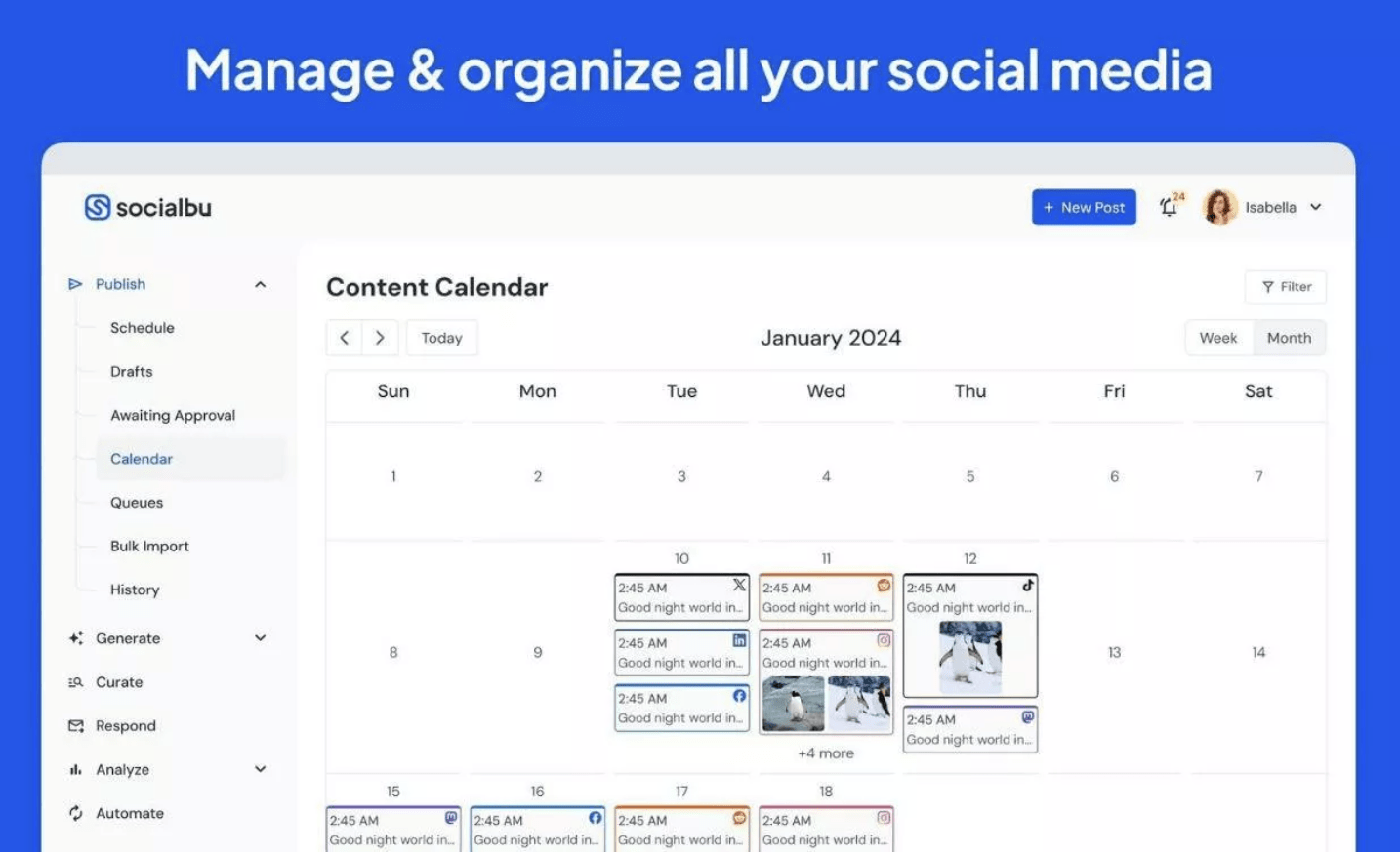
This organized approach can increase efficiency, reduce last-minute stress, and create a more cohesive brand message across all platforms. Moreover, mapping out your content in advance ensures a consistent posting schedule.
Solid content guidelines also help align your social media efforts with your B2B social media marketing objectives.
However, while a content calendar provides structure, it’s essential to remain flexible and adapt your plans based on current trends and audience feedback.
Creating and Maintaining the Calendar
To create a content calendar, start by determining the frequency of your posts. Based on your audience’s engagement patterns and available resources, consider how often you want to share content on each platform. Then, schedule your posts accordingly.
Update the calendar regularly to reflect changes in your strategy or audience feedback, ensuring it remains a living document that guides your content efforts.
Using SocialBu for your B2B marketing efforts will not only help with efficient content management but also grow your social presence effortlessly.
Audience Interaction
Engaging with your audience is crucial for building a solid community and fostering loyalty among your followers. When you interact with your audience, you create a sense of connection and belonging, encouraging them to engage more with your brand.
This interaction can increase trust and credibility, making your audience more likely to choose your products or services over competitors. Additionally, active engagement helps you gather valuable feedback and insights about your audience’s preferences and needs, allowing you to refine your content and offerings.
A strong relationship with your audience ultimately enhances customer retention and drives long-term success for your B2B brand.
Monitoring and Analyzing Performance
Like the best social media practices, regularly monitoring key performance indicators (KPIs) is essential for evaluating the effectiveness of your B2B social media strategy. Critical social media metrics to track include:
Engagement Rates
This metric measures how actively users interact with your content through likes, comments, shares, and clicks. High engagement rates indicate that your audience finds your content valuable and relevant.
Reach
Reach measures the number of unique users who see your content. Tracking reach helps you understand how far your content spreads and its visibility among your target audience.
Conversions
Conversion metrics assess how effectively your social media efforts drive desired actions, such as website visits, lead generation, or sales. By monitoring conversions, you can evaluate the impact of your social media campaigns on your overall business goals. It also helps you identify the areas for improvement.
For example, if you notice that certain types of content generate higher engagement, consider creating more of that content. Conversely, if specific posts consistently underperform, analyze why they may not resonate with your audience and adjust your approach accordingly.
Moreover, the social media landscape is constantly evolving, so be willing to adapt your strategy based on current trends and audience feedback to stay relevant.
Employee Advocacy
Employee advocacy can significantly amplify your B2B social media efforts. You can expand your reach, build trust, and establish thought leadership by encouraging your employees to share your content and engage with your audience.
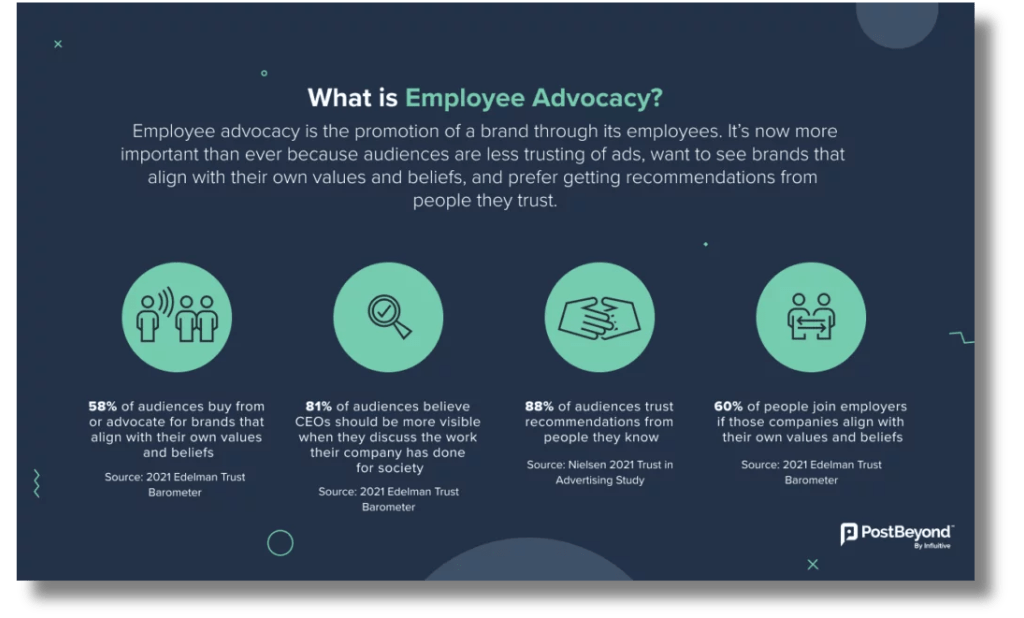
Here’s how you can do this:
- Provide Training and Resources: Equip your employees with the tools and knowledge they need to use social media effectively.
- Create Engaging Content: Develop content your employees can easily share and feel proud to be associated with.
- Recognize and Reward: Acknowledge and reward employees for their contributions to your social media efforts.
You also need to ensure that your employees understand your company’s tone and messaging. Create a clear set of guidelines that outline your expectations for employee social media behavior. Furthermore, it guides privacy, confidentiality, and appropriate content.
Fostering a culture of employee advocacy leads to utilizing your team’s expertise and enthusiasm to amplify your B2B social media efforts. Using LinkedIn Corporation to connect with other professionals and learn about industry news is advisable.
Conclusion
Conclusively, crafting a winning B2B social media marketing plan requires a multifaceted approach. This encompasses setting clear objectives, understanding your target audience, and choosing the right platforms.
You must also develop engaging content, implement a content calendar, and actively engage with your audience. Regularly monitoring performance is also an essential element.
Moreover, a successful B2B social media strategy is an ongoing process that requires dedication, adaptability, and a commitment to providing value to your audience. It also helps generate leads and strengthen your brand’s reputation.
FAQS
What is a B2B social media channel strategy?
A B2B social media channel strategy involves selecting the most appropriate platforms to reach and engage with a business audience. It considers factors like target audience demographics, content formats, and marketing objectives to determine which channels will be most effective for a B2B company’s social media efforts.
What social media is best for B2B?
LinkedIn is often considered the top social media platform for B2B marketing, with 78% of B2B marketers agreeing it’s the most effective channel for achieving their goals.
What is the B2B social media strategy in 2024?
In 2024, a successful B2B social media strategy should focus on creating educational, valuable content that builds trust and credibility. It should align with clear business objectives, such as lead generation, brand awareness, or thought leadership. The strategy should also prioritize engaging with the target audience, monitoring competitors, and adapting based on performance data.
What are the key success factors for B2B social media?
Key success factors for B2B social media include defining objectives, understanding the target audience, creating relevant content, choosing the right platforms, engaging in conversations, and monitoring performance. Consistency, a unique brand voice, and adapting to trends are also important for success.
How to increase B2B social media engagement?
To increase B2B social media engagement, focus on creating content that educates and informs the audience. Also, engage in conversations, respond to comments, and participate in relevant discussions.
How does B2B use social media?
B2B companies use social media to build brand awareness, generate leads, establish thought leadership, and foster relationships with other businesses.
